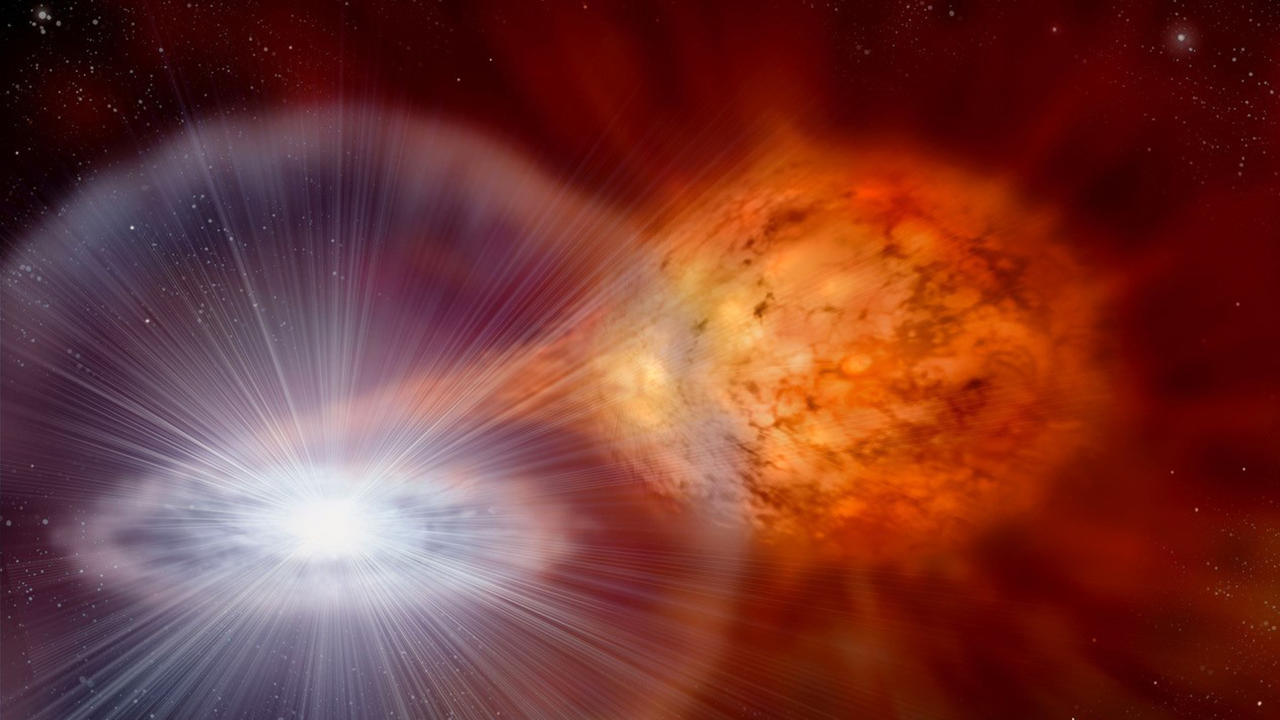
Artist’s conception of an explosion in a well-studied nova. Illustration: David A. Hardy.
From time immemorial, people have asked, “Where did we come from?”
Today, it’s clear our solar system condensed out of an interstellar cloud containing all the known elements. Something must have spread those elements into the void of space, and most astrophysicists agree it was supernovae—especially type Ia supernovae, the brightest visible explosions in the Universe.
“The catastrophic ends of some stars are the origins of many life-sustaining elements, such as carbon, oxygen, and the iron in our blood,” said University of Minnesota researcher Chick Woodward, PhD, a professor in the Minnesota Institute for Astrophysics, College of Science and Engineering.
But an understanding of all the types of stellar systems that could explode as supernovae remain elusive. One somewhat controversial candidate is tiny, dense stars called white dwarfs, which pack a mass comparable to the sun’s into a volume smaller than Earth’s.
Now, Woodward and colleagues at Arizona State University (ASU; the lead institution) and elsewhere have simulated, using advanced computer codes, several possible life cycles for a common type of white dwarf and compared their results with telescopic observations. They found these stars able to generate conditions that lead them to explode as supernovae and seed space with the germs of new stars, planets, and life.
“These little stars now have a seat at the table,” said Woodward.
The study appears in the Astrophysical Journal.
Settling a Debate
The question: Are white dwarfs up to the task of going supernova?
These stars begin as ordinary sun-like stars that condense from a primordial cloud of mostly hydrogen gas. Eventually, they start fusing hydrogen atoms to make helium, and then helium atoms to make heavier elements like carbon and oxygen. This generates heat and outward pressure that balances the inward tug of gravity.
In a few billion years, the hydrogen and helium run out, fusion ceases, the outward pressure drops, and the star undergoes gravitational collapse. As gravity compresses its atoms into an incredibly dense “degenerate” state, the star shrinks to a planet-sized white dwarf.
But if the collapsing star has more than 1.44 times the sun’s mass, its crushing gravity tries to compress the atoms beyond what the laws of physics allow. The atoms forcefully push back, causing a supernova explosion that rips the star apart. This mass limit is called the Chandrasekhar limit, after physicist Subrahmanyan Chandrasekhar, who proposed the idea.
Many stars form in pairs, and when one member becomes a white dwarf, it may accumulate, or accrete, gas flowing from its companion and thus increase its own mass. When it has accreted enough gas, it sparks a “thermonuclear runaway” event, in which uncontrolled nuclear fusion releases tremendous heat and leads the star to eject some material in a visible “nova outburst.” This cycle can repeat many times in a white dwarf’s lifetime.
The new simulations show that over time, contrary to what had been generally assumed, single white dwarfs often accumulate more mass from their companion stars than they eject. Therefore, their mass can keep growing until it reaches the Chandrasekhar limit and the stars explode as supernovae.
“Because the population of white dwarfs is much, much greater than single massive stars that end their lives as supernovae, their contribution to changing the local galactic chemistry over the age of the galaxy has been underappreciated,” said Woodward.
To develop this model, the researchers referenced observations of classical novae from many telescopes. Their previous work used ground-based telescopes, NASA’s orbiting Hubble and Spitzer telescopes, and the 747 airplane-borne observatory SOFIA.
“While we continue to work on theories, we’re looking forward to when we can use NASA’s James Webb Space Telescope and the newly named Nancy Grace Roman Space Telescope to observe novae and learn more about the origins of our Universe,” said study first author Sumner Starrfield, a Regents Professor of Astrophysics at ASU.
Of Earth and the Sun
The researchers’ simulations also showed that white dwarfs’ regular ejections of material must supply enormous amounts of lithium. If you’re reading this on a laptop or a smart phone, its lithium-ion battery probably holds remnants of such a star.
Some lithium was created in the “Big Bang” event that created the Universe. But to account for the amount in our galaxy today, more sources must be found.
“Our work suggests that over the age of the galaxy, exploding white dwarfs provide more than a third—and maybe all—of its lithium, which is quite remarkable,” Woodward said.
Billions of years from now, the sun will die by first swelling into a “red giant” star that engulfs Mercury, Venus and Earth, then collapsing into a tiny white dwarf. But the sun has no companion star to lend it mass, so it will end as a burned-out cinder, having never left galactic offspring from a supernova that lit up a far-off sky.